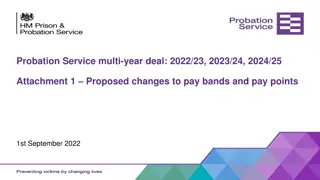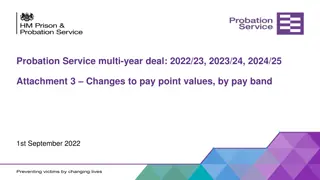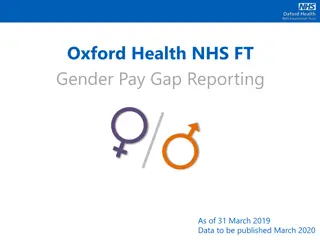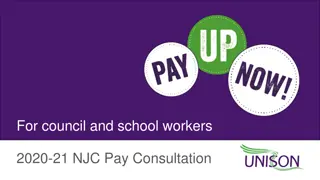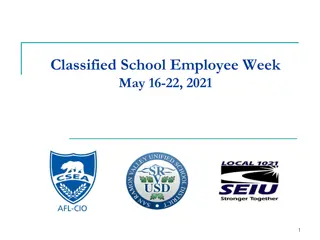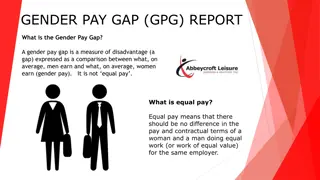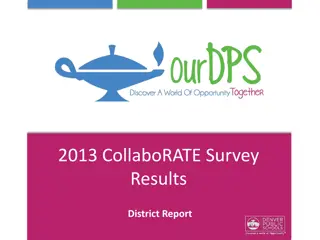
Effective Implementation Strategies for Classified Employee Pay Increase in Durham Public Schools
"Explore key observations and findings from a salary study aimed at improving classified employee pay in Durham Public Schools. Learn about the challenges faced during implementation and the importance of aligning with market-based data and state legislated increases."
Download Presentation

Please find below an Image/Link to download the presentation.
The content on the website is provided AS IS for your information and personal use only. It may not be sold, licensed, or shared on other websites without obtaining consent from the author. If you encounter any issues during the download, it is possible that the publisher has removed the file from their server.
You are allowed to download the files provided on this website for personal or commercial use, subject to the condition that they are used lawfully. All files are the property of their respective owners.
The content on the website is provided AS IS for your information and personal use only. It may not be sold, licensed, or shared on other websites without obtaining consent from the author.
E N D
Presentation Transcript
Durham Public Schools Classified Employee Pay Increase Kerry G. Crutchfield
Observations and Findings - Salary Study The salary study was needed and very helpful It provided excellent data on market-based pay in the Durham area It translated that market-based pay data into classifications that should help Durham Public Schools attract and retain qualified employees in its various classified job roles It addressed needed pay range expansion in the lower pay grades, after the state s mandatory $15 per hour minimum significantly compressed them 3
Observations and Findings Salary Study The published study had a couple of important omissions: No recommended implementation plan No estimated cost of implementation 4
Observations and Findings Salary Study Implementation One important difference between the DPS previous schedules and the recommended schedules was critically important to factor into the implementation plan: Previous schedules had experience step increments averaging 0.85% New schedules have experience step increments of 1.5% That difference compounded over 30+ step schedules creates pay ranges approximately double the size of the previous pay ranges 5
Observations and Findings Salary Study Implementation Using experience steps earned at 0.85% to place employees on a schedule with 1.5% experience steps is like trying to force a square peg into a round hole No method of using prior experience to place employees on the new schedules was going to yield an appropriate result not year-for-year as the study was implemented, and not state longevity years as alternatively suggested 6
Observations and Findings Salary Study Implementation Another implementation problem was the order of implementing the state legislated 4% increase and the salary study increases Since the salary study was completed in 2022-23, its recommended ranges were based on the market data of that year The study ranges should have been implemented first and then increased by the 4% state legislated increase Instead, the 2022-23 ranges were implemented without the legislated increase and are now approximately 4% behind the cost-of-living 7
Observations and Findings Salary Study Implementation The goal was, or at least should have been, to give all classified employees whose pay was below market a market-based pay increase Instead, many employees with 20+ years of experience received pay increases of 25%-35%, when their pay was only 10% or less below market The result was inevitable the cost of the implementation plan was not sustainable within the current DPS budget 8
What Should Happen Next? A new, market-based implementation plan is needed going forward The new schedule pay grade minimums compared to the previous schedule pay grade minimums were an accurate measure of needed market-based changes in pay as of last school year When that comparison is an increase, that percentage increase should be calculated, and all employees in that pay classification should have their increase based on that percentage plus the legislated 4% increase 9
What Should Happen Next? For example, elementary school data managers are recommended for the market-based pay grade D, with minimum pay of $3,174 per month The previous classification plan paid elementary school data managers on pay grade 59. with minimum pay of $2,938 per month The market-based minimum is 8.0% higher than the previous minimum, based on last year s market data, 12% higher including the legislated increase All elementary school data managers 2023-24 monthly pay increases should have been based on that 12% calculation 10
What Should Happen Next? Results of the Current Implementation Prev. Step Prev Pay New Step New Pay Increase % Increase 0 $2,938 0 $3,174 $236 8.0% 8 $3,003 8 $3,576 $573 19.1% 15 $3,205 15 $3,969 $764 23.8% 23 $3,533 23 $4,470 $937 26.5% 29 $,3799 29 $4,887 $1,088 28.6% 11
What Should Happen Next? Based on 40+ years of salary administration experience, I recommend any new implementation plan: Be prospective, not retroactive, and not require repayments Have an implementation date far enough out that all employees can be notified of their new pay amount at least a month in advance 12
What Should Happen Next? Due to the lack of sustainability of the current implementation, I understand the Board is considering a couple of potential interim cost-savings plans for the remainder of this fiscal year, including: Providing all classified employees a 15% increase over 2022-23 Providing all classified employees an 11% increase over 2022-23 Either option would be inclusive of the state legislative 4% increase 13
What Should Happen Next? My recommendation would be the 11% increase for two reasons It is closer to within the budgeted funds Since the salary study did not recommend reclassification increases for all groups of classified employees, a 15% increase for such employees might require significant pay decreases when a permanent plan is implemented 14
What Should Happen Next? If the Board wishes, I can work on a permanent implementation plan that utilizes the Study s market- based research and better fits within the Board s available budgeted funds I might be able to have such a plan ready for review by early March 15
Additional Recommendations Salary schedules should be approved by the Board Reclassifications should be guided by Board Policy or Regulation If there is no plan to reverse the reclassification implementation and require repayments, the Board should formally approve the new schedules and the current implementation for whatever period of time it remains in place The Board should formally approve any revised implementation plan and its effective date 16
What Should Happen Next Year The Board should approve a permanent set of schedules and an implementation plan as soon as possible, to be effective July 1, 2024 Employees should be notified of their 2024-25 pay rates, before any legislated increases, before the end of this school year As soon as possible, the Board should adopt a salary administration Policy and/or Regulation, which I can draft if the Board wishes The 2024-25 Budget will need to be prepared considering the implementation costs 17







